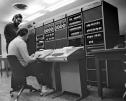The time has come to upgrade my server to handle some beefier workloads, so I hopped over to eBay and picked up a Sun Fire T2000 with 16GB of RAM and the 8-core 1.0Ghz Niagara CPU. Once I slap in four new 73GB SAS drives and load up the best Linux distro of all time (Debian, of course) this new box will replace my current server as the primary Nekoware mirror.
So far, my biggest complaint without actually touching the box is an apparent lack of RAID options beyond 0 and 1. With 4 disks, I'm certainly not going to stripe - I would like to have a RAID5 array at least. However, it looks like the best I can do is use two RAID1 arrays and set them up as LVM PVs to get one large contiguous disk area. Does anyone have a better idea, or know of a way to get RAID5 working on these boxes? I could buy an external controller if necessary.
Also, to avoid the PITA ILOM firmware issues I had with my last Sun box, I've got updated firmware files ready and waiting.
Does anyone here have experience with the Sun/Oracle Niagara-based servers, and if so, do you have any complaints or tips for getting the most out of them?
So far, my biggest complaint without actually touching the box is an apparent lack of RAID options beyond 0 and 1. With 4 disks, I'm certainly not going to stripe - I would like to have a RAID5 array at least. However, it looks like the best I can do is use two RAID1 arrays and set them up as LVM PVs to get one large contiguous disk area. Does anyone have a better idea, or know of a way to get RAID5 working on these boxes? I could buy an external controller if necessary.
Also, to avoid the PITA ILOM firmware issues I had with my last Sun box, I've got updated firmware files ready and waiting.
Does anyone here have experience with the Sun/Oracle Niagara-based servers, and if so, do you have any complaints or tips for getting the most out of them?












